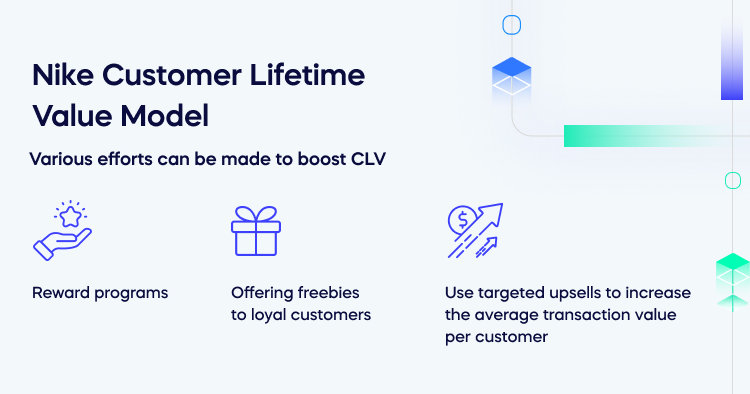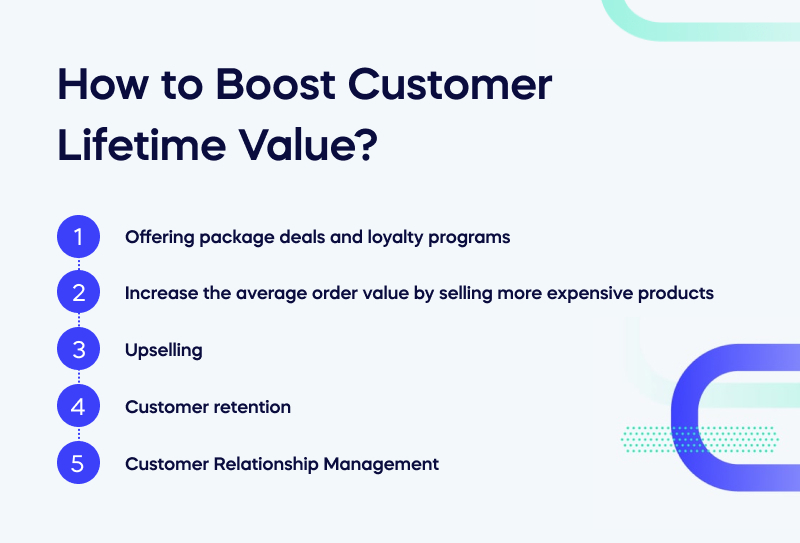
What is Customer Lifetime Value?
There are certain metrics on the basis of which a business scales and grows like net profit margin, sales, revenue, retention, customer lifetime value, and others. Customer Lifetime Value or CLV represents the total funds a consumer spends at a business for products and services without any specific time measurements restricting the data. You can find the customer lifetime value with the right tools. This value is a great indicator for an enterprise to know and understand its customers’ loyalty.
Who do you think brings more revenue to your business, a customer who makes one big purchase or a customer who makes smaller but repeated purchases? The latter tends to bring more revenue to the business and is considered a loyal customer. Thus, customer retention which tells us how many customers a business is able to retain over a specific period of time is an absolutely important gold standard metric to understand a business’s current health and improve it further.
How do you Calculate the Customer Lifetime Value of a Product?

Even though there is more than one way to calculate Customer Lifetime Value that includes a historical, predictive, and traditional approach, the best approach for your business depends upon your business type and resources. Having said that, the predictive formula helps a business understand the present value of a customer and how that may change in the future. Thus, this formula is used to calculate the total revenue that a business could generate from a customer over their entire lifetime and that formula is mentioned below.
The formula is expressed as
CLV = T x AOV x AGM x ALT / Number of customers for a particular time period
where,
T = Average number of transactions per month
AOV = Average order value
AGM = Average gross margin
ALT = Average customer lifespan in months
Why is it Important to Know the Customer Lifetime Value?
The calculation of Customer Lifetime Value helps a business understand major aspects that involve a customer, know how much can be expected from existing customers, and recognize the health of the company. This will also help you understand if there is a requirement for you to invest in retention, product development, or customer service as customer satisfaction does play a major role in influencing the CLV.
Nike Customer Lifetime Value Model
Nike is a sports apparel brand that has been known for its co-branded marketing initiatives, campaigns, and promotions. The brand split up its customers between two categories – low CLV customers and high CLV customers. Customer Lifetime Value (CLV) is one of the publicly available data sources that is considered a driving factor for Nike’s loyalty data evaluation. Nevertheless, the company also acquired Zodiac Inc., a consumer data analytics company in 2018, the major reason being the company’s digital transformation plans that orbit around customer lifetime value. Nike’s digital plans focus on consumers and as it keeps that in mind, it carries a strong analytics team for backup.
Nike grew its customer lifetime value by paying more attention to the customer who makes two transactions per year over the person who makes only one. Although both customers are providing value, the way CLV works, it will lead the company to pay more attention to the consumers that provide more revenue to the company in specific categories.
Various efforts can be made to boost CLV –
-
Reward programs
-
Offering freebies to loyal customers
-
Use targeted upsells to increase the average transaction value per customer
Nike offers a membership program that requires you to download their mobile application which offers free shipping and returns, a unique collection of its products that is only available to its members, and offers, and deals on birthdays and other occasions.
What is a Good Lifetime Value of a Customer?
Customer loyalty and lifetime value are metrics that are interdependent on one another and both impact a company’s bottom line. Therefore, there is customer lifetime value and then there is customer acquisition cost (CAC), and comparing both metrics will tell you if the CLV is good for your company or not. So, there are different variables on which the CLV depends. Customer Acquisition Cost is the amount of money that a business spends to get a customer to make a purchase of a product or service. And we call a CLV strong when it is three times more than the CAC value. In cases where the CLV is lesser than that, it means the profit margin is low for your business. This indicates that you either do not have a functional marketing strategy or the one you have been working on is not generating ROI.
How to Boost Customer Lifetime Value?

The Customer Lifetime Value can be increased by escalating the average order value or your average purchase frequency. That can be done by –
- Offering package deals and loyalty programs that provide customers with offers and discounts is a great way to increase customer expenditure and brand loyalty.
-
Increase the average order value by selling more expensive products. While you sell expensive products, you also need to ensure the quality of the same. The high quality of the product should be used as the USP of the product which can be showcased by displaying images, good reviews by the existing customers, and quality content that describes the product well.
-
Upselling is a great way to increase sales and experience rapid business growth. Selling extras like an extended warranty, accessories or other related products that the customer might be highly interested in buying can help increase the CLV of your company.
-
Customer retention is a strategy that can be accomplished by sending emails that include appealing yet time-sensitive offers and a call-to-action. Time-based offers are more impactful as they generate an urgency that makes the customers want to take immediate action.
-
Customer Relationship Management helps build a brand’s social media presence. Social media can help brands interact with their customers, provide consistent customer experience and support, and build a relationship with them. This type of responsiveness can work positively for a brand’s online presence.
What is Apple’s Customer Lifetime Value?
Apple is the largest technology company by revenue and by market capitalization and so it has clearly managed to set up an exceptional customer base. The tech company delivers high customer value by delivering good quality products and a great customer experience. Their focus has been on customer loyalty and average retention time, which is cultivated by providing customer’s convenience and personalization.
According to our analysis, Apple can potentially generate a Customer Lifetime Value (CLV) of US$2,400 over a period of 30 months from a “power” iPhone user with the latest hardware subscribing to its existing and new Apple services. (Source: Counterpoint Research)
Apple’s Genius Bar offers customers free help and support for their products that are under warranty. It also has a committed online forum that has experts answering questions that take care of most customer problems. This after-sales service that Apple provides its customers shows that the company cares about them. Time and again, it keeps presenting a series of bundles of its products and services that work towards improving the customer lifetime value.
Net Promoter Score (NPS) is a metric that is associated with the company’s growth and customer retention levels. On that subject, Apple has the highest net promoter score in the technology industry which positively impacts the CLV.
What is the Difference between Customer Lifetime Value and Customer Equity?
Both CLV and customer equity are important metrics that are used to identify opportunities and develop efficient marketing strategies that work well for a business. While we have been talking a lot about customer lifetime value in this blog, customer equity on the other hand is the sum total of all customer lifetime values for a business which means that the customer equity of a firm is calculated on the basis of CLV for each customer. The formula used to calculate customer equity is mentioned below.
Customer Equity = sum of all customer lifetime values of the current and future customers
Customer equity provides a business with insights that will help them identify and target customers that are interested in the brand and avoid disturbing random people with advertising messages. People who follow the brand on social media, have subscribed to the emails, and those who have made purchases with the brand previously are the potential customers who are likely to be influenced by the marketing efforts of the business. Thus, a high level of customer equity increases the overall value of the company.

